Physical Address
304 North Cardinal St.
Dorchester Center, MA 02124
Several bacterial species included in the genus Bartonella, and the pathogens Coxiella burnetii and Tropheryma whipplei, cause a remarkably wide and diverse spectrum of infectious disease syndromes that pose particularly difficult diagnostic challenges for anatomic pathologists. These agents stain poorly or not at all with conventional tissue Gram stains, have fastidious culture requirements, and are uncommonly considered in most differential diagnoses. In addition, each of these pathogens can cause systemic illnesses in vulnerable hosts that are often fatal when the diagnosis is missed or delayed; because effective antimicrobial therapy exists for each of these pathogens, an early diagnosis can be critical. Surgical procedures for blood culture-negative endocarditis or peripheral lymphadenopathy provide pathologists the most commonly evaluated tissue samples for these conditions.
Bartonellae are small (0.5 to 0.6 μm × 1 to 2.5 μm), slightly curved, pleomorphic, gram-negative bacteria that share a close evolutionary history with the genera Brucella, Agrobacterium, Rhizobium, and related taxa in the class Alphaproteobacteria. Many wild and domesticated animals serve as natural reservoir hosts for these facultatively intracellular hemotropic bacteria that are transmitted by various blood-feeding arthropods, including fleas, lice, mites, and sandflies. Each Bartonella species is associated with at least one natural host in which bacteria establish persistent intraerythrocytic infections. Other than Bartonella bacilliformis, the agent of Carrión disease, and Bartonella quintana, the agent of trench fever, it is believed that Bartonella species exist primarily or exclusively in cycles of enzootic infection that involve humans only as accidental hosts; however at least 10 other species of Bartonella have been associated with human illnesses since 1990 ( Table 18-1 ), and it is likely that many others will be identified as pathogens in years to come. The spectrum of histopathology attributable to infections with Bartonella species is remarkably varied and may depend on the immunologic status of the host, the tissue involved, or the temporal evaluation of the lesion. Because multiple Bartonella species share several clinical syndromes, it is also reasonable to assume that the range of pathology associated with some of the more recently recognized pathogens will expand to include certain manifestations associated with historically identified species.
| Bartonella Species | Year of Initial Isolation | Reservoir Host(s) | Documented Clinical Manifestation(s) in Order of Frequency |
|---|---|---|---|
| B. bacilliformis | 1919 | Human | Carrión disease (verruga peruana, Oroya fever) |
| B. quintana | 1961 | Human, monkey | Trench fever, endocarditis, bacillary angiomatosis, granulomatous lymphadenitis, osteomyelitis |
| B. henselae | 1990 | Cat | Cat scratch disease, hepatosplenic disease, endocarditis, bacteremia, bacillary angiomatosis, neuroretinitis, osteomyelitis |
| B. elizabethae | 1993 | Rat | Endocarditis |
| B. vinsonii berkhoffii | 1995 | Coyote, dog | Endocarditis |
| B. grahamii | 1995 | Mouse, vole | Neuroretinitis |
| B. alsatica | 1999 | Rabbit | Endocarditis, granulomatous lymphadenitis |
| B. koehlerae | 1999 | Cat | Endocarditis |
| B. vinsonii arupensis | 1999 | Mouse, dog | Endocarditis, bacteremia |
| B. washoensis | 2000 | Ground squirrel | Bacteremia, myocarditis |
| B. rochalimae | 2007 | Dog | Bacteremia |
| B. tamiae | 2008 | Rat | Bacteremia |
| B. mayotimonensis | 2010 | Unknown | Endocarditis |
Bartonella henselae is the most commonly encountered pathogenic Bartonella species, and infection with this agent manifests most frequently as cat scratch disease (CSD). Domesticated cats are the primary reservoir of B. henselae, and the pathogen is transmitted among felines by cat fleas (Ctenocephalides felis). Human infections result from inoculation of infectious flea feces into a cutaneous wound created from a cat scratch or occasionally by direct inoculation onto the conjunctiva. The close association of humans with domesticated cats creates an enormous pool of reservoir hosts, and cat ownership, particularly ownership of a young cat or a kitten, is a significant risk factor for cat scratch disease. Most cases occur in children; indeed, cat scratch disease is the most common cause of unilateral regional lymphadenitis in children other than obvious cutaneous infection. Most cases are reported during the fall and winter months, which is believed related to the feline reproductive cycles and flea activity.
In classical cat scratch disease, a small (2 to 5 mm) erythematous papule forms within 3 to 10 days at the inoculation site. Approximately 33% to 60% of patients develop a transient low-grade fever. Ipsilateral lymphadenitis develops at the site of one or more draining lymph nodes within 1 to 7 weeks after inoculation, most commonly in the axillary, epitrochlear, cervical, submandibular, or inguinal regions. The involved nodes are typically enlarged and tender and the overlying skin is often erythematous. The adenopathy consists of a single or several enlarged nodes in one region in approximately two thirds of patients. A minority will have enlarged nodes in multiple anatomic sites, suggesting multiple inoculations. Suppurative changes occur in approximately 10% to 15%. Lymphadenopathy generally persists for 2 to 4 months but may last considerably longer.
Approximately 1% of patients infected with B. henselae develop a systemic illness characterized by malaise, abdominal pain, and persistent fever lasting several weeks to months. In these patients, granulomas form in the liver, spleen, or both organs, accompanied frequently by enlarged lymph nodes in the hilum of the spleen or liver or around the pancreas or aorta. Some patients also exhibit peripheral lymphadenopathy at sites associated with classical cat scratch disease, including the axillary and inguinal regions. Splenomegaly occurs more commonly than hepatomegaly, but the involved organs may also be normal in size. When imaged by using ultrasonography or computed tomography, the visceral granulomas appear as hypoechoic or low attenuation lesions. Collectively, these findings are sometimes mistaken for malignant neoplasms but typically resolve within 2 to10 months and leave no sequelae other than a small calcified focus. Spontaneous splenic rupture attributed to infection with B. henselae has been reported. Hepatosplenic disease is identified more frequently in children than in adults.
At least eight Bartonella species are recognized causes of infective endocarditis. In several series, Bartonella species have been associated with approximately 2% to 4% of all patients with infective endocarditis and as many as 10% to 35% of all cases of blood culture–negative infective endocarditis. At least seven species or subspecies are known to cause endocarditis, including B. henselae, B. quintana, B. elizabethae, B. vinsonii berkhoffii, B. vinsonii arupensis, B. kohlerae, and B. alsatica; however, the great majority of reported cases of Bartonella endocarditis in the United States have been associated with B. henselae . In France, most described cases are caused by B. quintana and occur most commonly among homeless alcoholic patients infested with body lice. A preexisting valvulopathy is recognized in approximately 40% of endocarditis patients infected with B. quintana and as many as 90% of those infected with B. henselae . Infection of the aortic valve alone occurs in approximately 65% of cases of Bartonella endocarditis, followed by the mitral valve alone in 19%, and simultaneous infection of the mitral and aortic valves in 12%. The tricuspid and pulmonic valves are almost never involved. Embolic phenomena occur in approximately 35% of patients. Vegetations are recognizable by echocardiography in > 90% of patients. Bartonella endocarditis is a life-threatening disease, and a series of 48 patients reported a case-fatality rate of 8% despite surgical and antibiotic interventions.
In persons with severe immune-suppressing conditions, particularly advanced human immunodeficiency virus (HIV) disease, transplantation, and malignancy, infections with B. henselae and B. quintana can cause vasoproliferative lesions in various tissues and organs including skin, central nervous system, bone and bone marrow, cardiac and skeletal muscle, conjunctiva, and the mucosal surfaces of the gastrointestinal and respiratory tracts. Cutaneous bacillary angiomatosis is the most frequently reported manifestation; however, involvement of other organ systems and deep tissues may occur in the absence of skin lesions. Most cases of bacillary angiomatosis are reported from patients with acquired immune deficiency syndrome with CD4 lymphocyte counts < 100 cells/mL. This condition has also been identified in patients receiving cytotoxic and immune-suppressing chemotherapy and very rarely in immune-competent persons. In bacillary peliosis, these lesions form in the liver, spleen, or both organs, generally in the context of hepatomegaly and splenomegaly. Although B. henselae and B. quintana are equally likely to cause cutaneous bacillary angiomatosis, clinical comparisons suggest that B. henselae is more likely to involve the lymph nodes, spleen, and liver, whereas B. quintana infections are more likely to cause lytic bone lesions or deep soft tissue disease ( Table 18-2 ). Bacillary angiomatosis resolves rapidly in response to antimicrobial therapy; however, the infection can be fatal if not treated appropriately.
| Site * | Bartonella henselae (N = 30) | Bartonella quintana (N = 26) |
|---|---|---|
| Skin | 22 | 23 |
| Lymph node | 13 | 1 |
| Liver or spleen | 6 | 0 |
| Subcutaneous mass | 1 | 8 |
| Bone | 0 | 9 |
* Several patients had lesions involving multiple anatomic sites.
Carrión disease, or bartonellosis, is a biphasic illness caused by infection with Bartonella bacilliformis . This disease, initially described during the pre–Colombian era, is endemic to certain river valleys on the western slope of the Andes Mountains in Peru, Colombia, and Ecuador, where as many as 5% to 10% of apparently healthy persons have persistent infections. Humans represent the only known reservoir of B. bacilliformis, which is transmitted among susceptible persons by various species of phlebotomine sandflies, including Lutzomyia verrucarum . Carrión disease is represented by two distinct clinical syndromes: an acute and potentially life-threatening phase known as Oroya fever and a subsequent and less severe eruptive stage termed verruga peruana that is characterized by vasoproliferative skin lesions that resemble the cutaneous lesions of bacillary angiomatosis. Oroya fever is characterized by extensive intraerythrocytic infection, often involving > 90% of red cells, that causes severe and sometimes fatal hemolytic anemia. Some historical outbreaks were associated with thousands of deaths, but contemporary case fatality rates are < 10%. Verruga peruana may develop weeks to months after Oroya fever, and the lesions can persist for months to years. In addition to the skin lesions, verrugae may occur occasionally on the conjunctivas and oral and nasal mucosae. Early investigators described involvement of various other internal organs and tissues, including the mucous membranes of the gastrointestinal and genitourinary tracts, central nervous system, lungs, liver, pancreas, kidneys, and spleen; however, contemporary descriptions of similarly distributed verrugae are lacking.
Bartonella species, particularly B. henselae, may cause other tissue-associated infections, including osteomyelitis and neuroretinitis, although surgical pathologists seldom encounter specimens from these sources. Osteomyelitis is a rare manifestation of cat scratch disease that most frequently involves bones of the vertebral column or pelvic girdle of children. Fever and concomitant lymphadenopathy are seen in approximately 75% of these patients. Sampled lesions may show granulomatous inflammation and stellate microabscesses but more often reveal small foci of neutrophilic infiltrates.
Localized or systemic infections caused by arthropod-borne bacteria in the genus Bartonella that include cat scratch disease, bacillary angiomatosis, infective endocarditis, and Carrión disease.
Cat scratch disease lymphadenopathy is the most common manifestation of B. henselae infection.
Cat scratch disease has a cosmopolitan distribution and most cases are reported during the fall and winter.
Hepatosplenic disease occurs in approximately 1% of patients infected with B. henselae.
At least eight different species of Bartonella cause endocarditis, and collectively these may cause as many as 10% to 35% of all cases of blood culture-negative endocarditis.
B. henselae is most commonly reported as a cause of endocarditis in the United States, and B. quintana is identified more frequently in Europe.
Bacillary angiomatosis is caused by infection with B. henselae or B. quintana and occurs predominantly in severely immunocompromised patients, particularly those with advanced HIV disease or malignancy.
Carrión disease is caused by B. bacilliformis and is endemic to river valleys in Peru, Colombia, and Ecuador, where as many as 5% to 10% of apparently healthy persons are persistently infected.
Classical cat scratch disease typically runs a benign course; however, lymphadenopathy often persists for several months.
Hepatosplenic cat scratch disease generally resolves within 2 to 10 months, but the lesions may be mistaken for malignancy by imaging studies.
Bartonella endocarditis is generally fatal if not treated appropriately.
Involvement of deep tissues or organs by bacillary peliosis may be fatal if not treated appropriately.
Oroya fever, the hematic phase of Carrión disease, is associated with a case-fatality rate of < 10%.
Most cases of classical cat scratch disease occur in children.
Bartonella endocarditis more frequently identified in adult patients, particularly those with a preexisting valvulopathy.
B. quintana endocarditis reported primarily among homeless, lice-infested patients.
Cat scratch disease is associated with fever and tender lymphadenitis; suppurative changes noted in approximately 10% to 15%.
Hepatosplenic disease characterized by persistent fever, malaise, and abdominal pain, occasionally with hepatomegaly or splenomegaly.
In Bartonella endocarditis, infection of the aortic valve is most frequent; vegetations are recognizable by echocardiography in > 90%, and emboli are seen in approximately one third of patients.
Bacillary angiomatosis most frequently involves the skin, but lesions may also occur in almost any tissue or organ.
Oroya fever is the acute febrile phase of Carrión disease associated with potentially lethal hemolytic anemia; verruga peruana is the less severe, eruptive phase of the disease associated with cutaneous vasoproliferative lesions.
Cat scratch disease responds poorly to antibiotics, but azithromycin is recommended for patients with extensive lymphadenopathy.
Hepatosplenic cat scratch disease is treated with multiweek course of doxycycline and rifampin.
Bartonella endocarditis often requires surgical resection of the involved valve; recommended antibiotic therapy includes gentamicin in combination with doxycycline.
Bacillary angiomatosis may progress to severe or fatal disease in immunocompromised patients without antibiotic treatment; recommended therapies include doxycycline and erythromycin for several months.
Oroya fever is best treated with chloramphenicol in combination with a beta-lactam antibiotic; verruga peruana is treated with rifampin.
In classical cat scratch disease, the involved lymph nodes are generally 1 to 5 cm in greatest dimension but may be as large as 12 cm. There is often prominent nodularity and the nodes may be matted and adherent to the adjacent soft tissues. Ocular inoculation occurs in approximately 5% to 10% of cases and manifests as a nonsuppurative conjunctivitis, an ocular granuloma, or both ( Figure 18-1 ). In hepatosplenic disease, multiple gray-white nodules, measuring 0.2 to 1.5 cm, are scattered throughout the parenchyma and may bulge onto the surface of the liver or spleen when these are in situated subcapsular locations. The macroscopic appearance of cardiac valves infected with Bartonella species generally reveals small, compact vegetations that may be associated with one or more ruptured chordae or leaflet perforations.
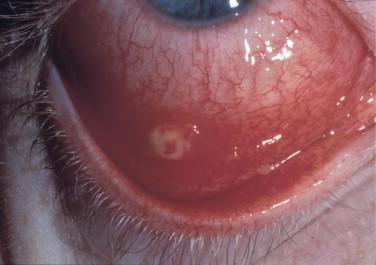
Cutaneous bacillary angiomatosis occurs singly or as multiple lesions, and the number of lesions is generally directly proportionate to the degree of immune suppression of the host. Most lesions appear as pink to deep red or violaceous papules and nodules that range from 0.2 to 2 cm and may become ulcerated or hyperkeratotic ( Figure 18-2 ). Peliotic lesions in the liver and spleen are generally small (0.1 to 0.2 cm) and are occasionally interspersed among larger foci of parenchymal necrosis.
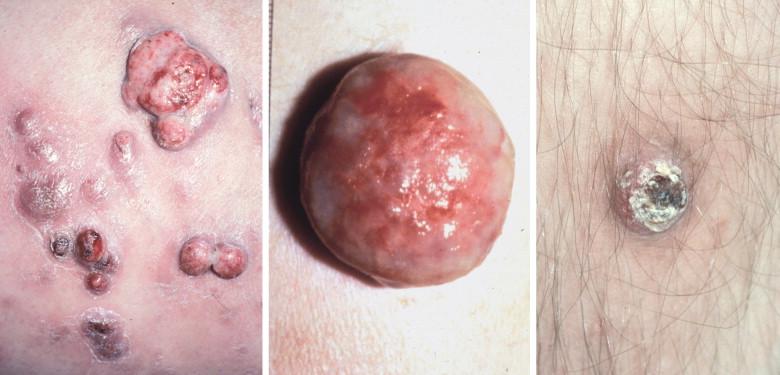
Three types of cutaneous eruptions are seen with verruga peruana. The most frequently identified are miliary lesions, observed in approximately 70% of patients. These are represented by multiple, 0.1- to 0.4-cm bright red to violaceous papules, occurring superficially on the face and extremities ( Figure 18-3 ). Nodular-type lesions are generally larger and may reach several centimeters in size. These verrugae are typically fewer in number but extend deeply into the subcutaneous tissue and are prone to hyperkeratosis and ulceration. Mular lesions are the least frequently observed and the largest of the eruptive types, ranging from 0.5 to 5.0 cm. These generally appear as single painful lesions and often become pedunculated or eroded.
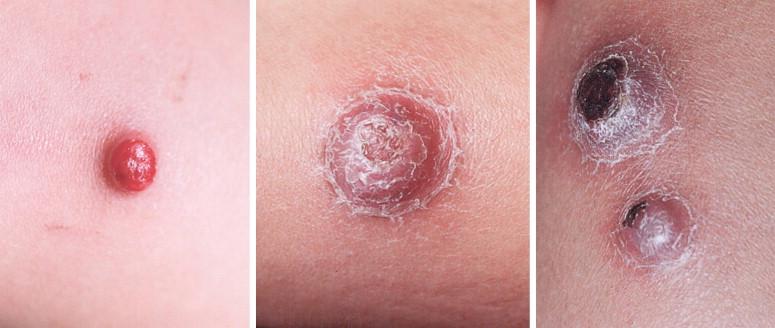
The histologic features of cat scratch evolve over the course of the infection. Initially, small cortical abscesses appear beneath the subcapsular sinus, followed by mixtures of neutrophilic and granulomatous inflammation and non-necrotizing granulomas with multinucleated giant cells in the cortex and medulla ( Figure 18-4 ). Eventually, the centers of some granulomas become irregularly contoured collections of neutrophils and necrotic debris surrounded by a rim of palisading macrophages. These so-called stellate microabscesses are considered the pathologic hallmark of cat scratch ( Figure 18-5 ). Other histologic features include capsular thickening and fibrosis, follicular hyperplasia, and vascular proliferation in the paracortical and subcapsular regions. Bartonella henselae bacilli are best detected using Warthin-Starry, Steiner, or Dieterle silver techniques and appear as minute (1 to 3 μm), delicate, pleomorphic rods that form branching chains or small clusters ( Figure 18-6 ). The bacilli are generally sparse and distributed sporadically, concentrated predominantly in small clusters in microabscesses that occur early during the progression of the disease. Intact bacilli may be absent from more advanced lesions. Bartonella alsatica and B. quintana have also been reported to cause granulomatous lymphadenitis with histologic findings identical to those of classical cat scratch disease. Biopsy specimens of conjunctival inoculation sites show ulcerated epithelium with mixed inflammatory infiltrates accompanied by focal hemorrhages, necrosis, and vascular proliferation. These lesions generally become granulomatous, and bacilli can be detected in the conjunctiva and in enlarged ipsilateral preauricular lymph nodes that often accompany the conjunctival lesion.
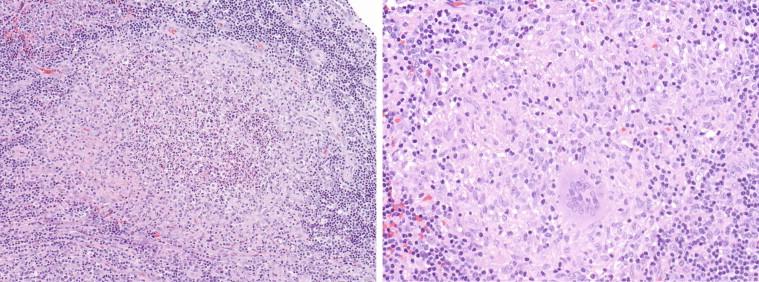
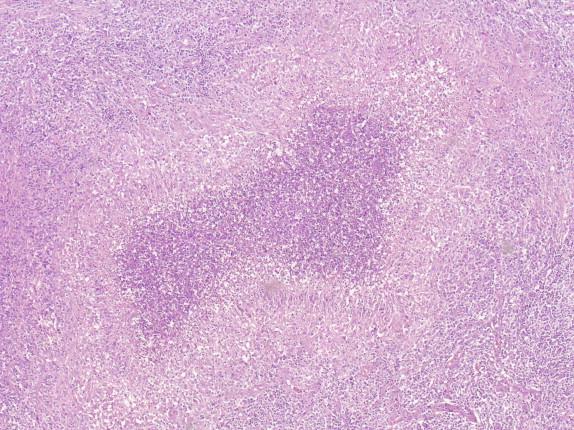
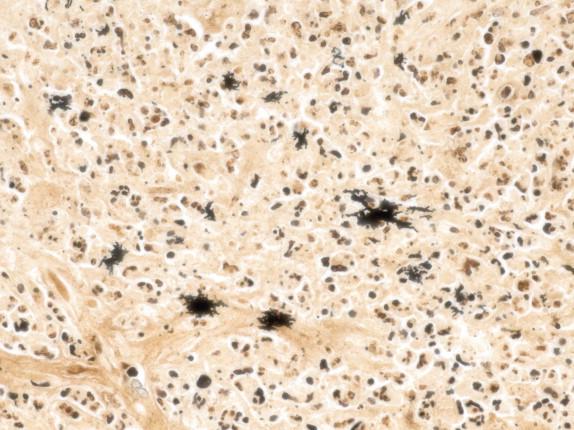
The histopathologic appearance of hepatosplenic disease includes a spectrum of granulomatous inflammation that ranges from small aggregates of macrophages with occasional multinucleated giant cells ( Figure 18-7 ) to large stellate microabscesses surrounded by an inner zone of palisaded histiocytes and an outer layer of lymphocytes. Hepatic lesions are distinguished by a peripheral rim of variably developed fibrosis and granulation tissue that is not identified in lymphoid or splenic lesions ( Figure 18-8 ). Enlarged intra-abdominal nodes may also show necrotizing granulomas with stellate microabscesses. Bacteria are occasionally identified in the center of the microabscesses.
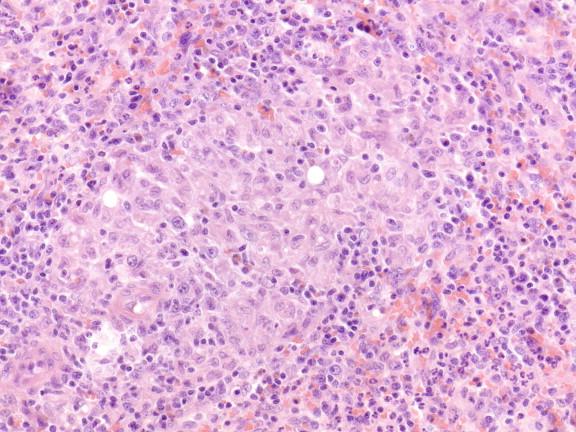
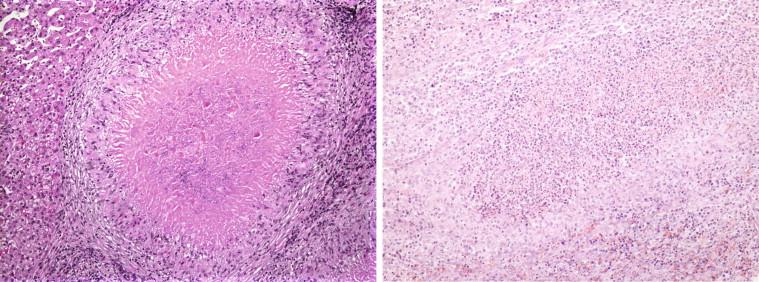
In Bartonella endocarditis, the involved valves are frequently mineralized and associated with prominent fibrosis and granulation tissue ( Figure 18-9 ). Inflammatory infiltrates are most frequently mononuclear but may also include some neutrophils, macrophages, and multinucleated giant cells ( Figure 18-10 ). Bartonellae appear most frequently as dense clusters of tiny, extracellular, rod-shaped bacteria enmeshed in fibrin along the valve margin, often in the absence of conspicuous inflammatory cell infiltrates ( Figure 18-11 ).
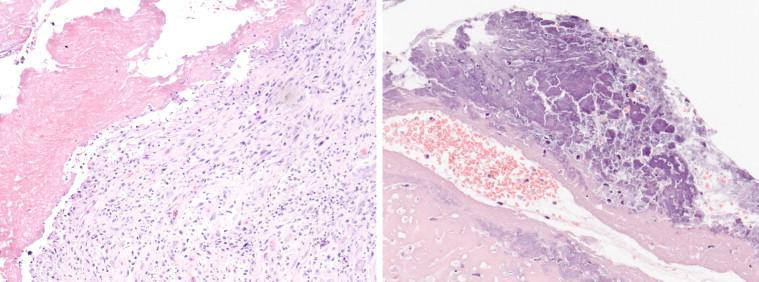
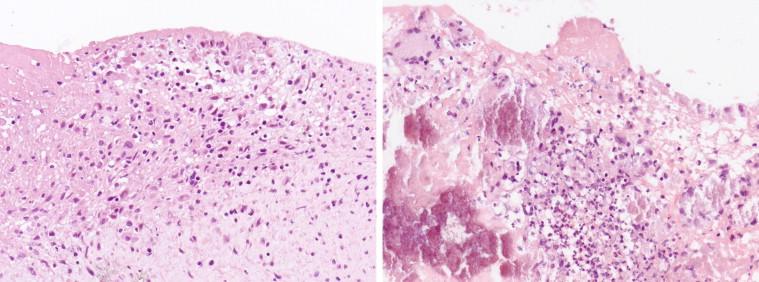
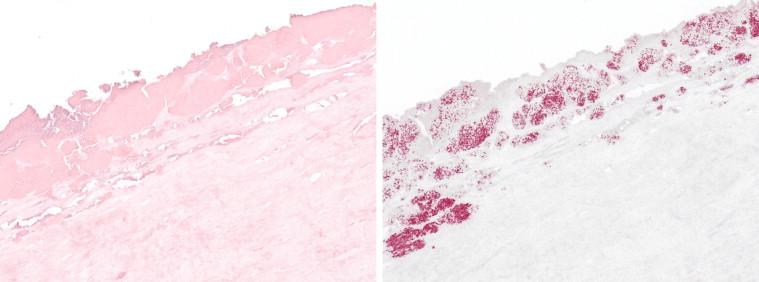
Bacillary angiomatosis is characterized by a well-circumscribed, lobular proliferation of small, rounded vessels lined by plump cuboidal cells with variable atypia ( Figure 18-12 ). A mixed population of proliferating cells, comprising dendrocytes and endothelium, is identified by immunocytochemistry. A fibrotic or mucinous-appearing stroma containing small clusters of intact and fragmented neutrophils separates the vascular spaces. Within the stroma and often situated near neutrophils are hazy purple and somewhat granular aggregates that represent dense clusters of bartonellae ( Figure 18-13 ). The pleomorphic bacteria are best demonstrated by using Dieterle, Steiner, or Warthin-Starry techniques ( Figure 18-14 ). In the liver and spleen, bacillary angiomatosis appears as multiple, small, and irregularly distributed blood-filled spaces, lined by flattened or cuboidal endothelial cells ( Figure 18-15 ). The peliotic spaces are separated by fibromyxoid stroma containing small clusters of neutrophils and bacteria ( Figure 18-16 ).
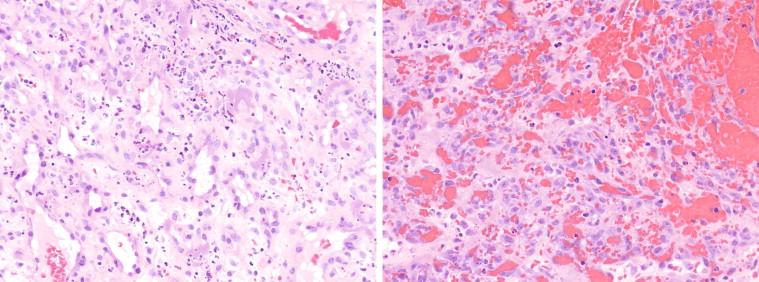
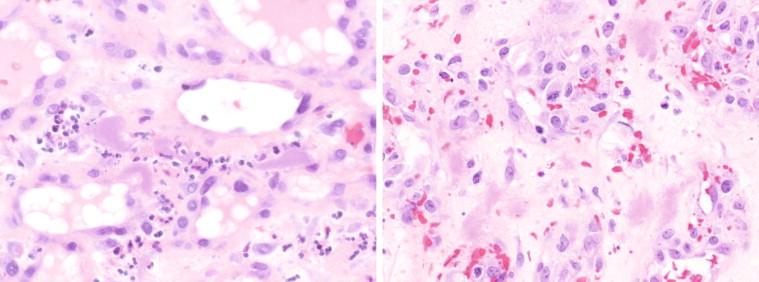
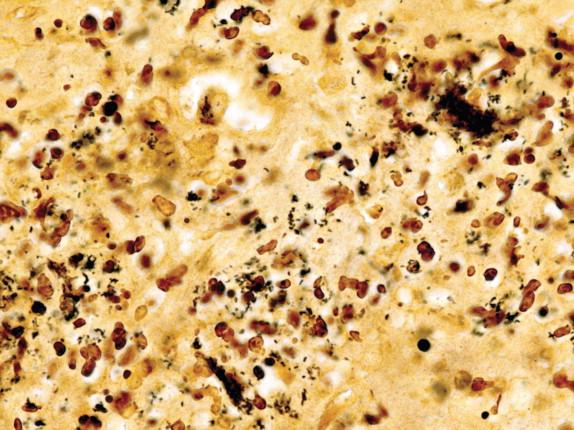
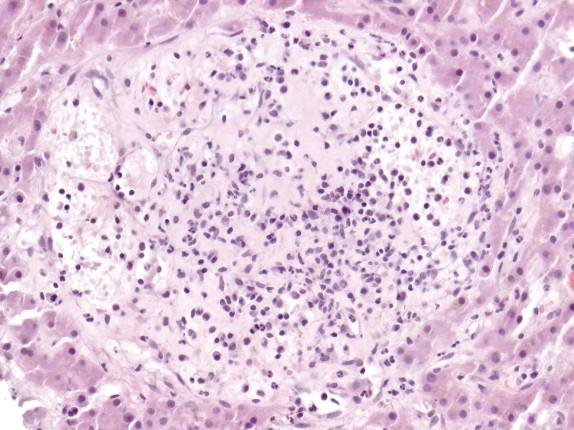
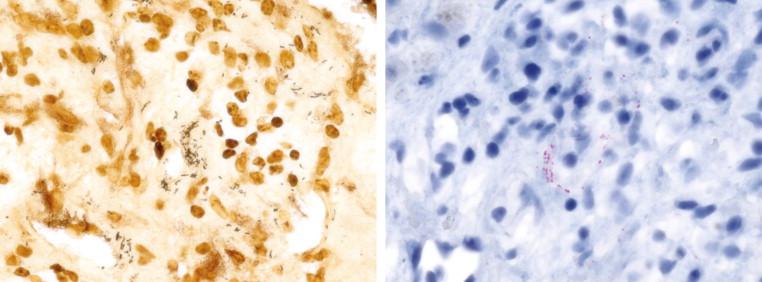
The cutaneous lesions of verruga peruana, regardless of the macroscopic appearance, are histologically similar to those of bacillary angiomatosis. Verrugae show multinodular and lobulated collections of plump endothelial cells and dermal dendrocytes. The vasoproliferative elements form solid sheets and cords as well as small vessels with patent lumens ( Figure 18-17 ). Some of the endothelial cells may be mitotically active and exhibit mild atypia. Giemsa stain reveals occasional intracytoplasmic conglomerates of rose-colored granules, known as Rocha-Lima inclusions, which represent phagosomes packed with degenerating B. bacilliformis bacteria. Small clumps of extracellular coccoid and ovoid bacteria can also be identified in the edematous stroma, although the number of bacilli are few relative to those seen in bacillary angiomatosis. Mononuclear inflammatory cell infiltrates, comprising predominantly lymphocytes and plasma cells, are generally seen in the interstitium; however, some verrugae contain neutrophilic microabscesses.
In cat scratch disease, the axillary, epitrochlear, cervical, submandibular, or inguinal lymph nodes are most frequently involved.
Enlarged nodes are generally 1 to 5 cm and the skin overlying the affected node is often erythematous.
In hepatosplenic disease, the parenchyma of the liver or spleen contain multiple gray-white nodules that measure 0.2 to 1.5 cm.
The vegetations of Bartonella endocarditis are typically small and compact.
Cutaneous bacillary angiomatosis appears as pink to violaceous papules and nodules that are from 0.2 to 2 cm in greatest dimension; peliotic lesions are generally considerably smaller, from 0.1 to 0.2 cm.
Three forms of vasoproliferative lesions are recognized with verruga peruana: miliary, nodular, and mular.
Cat scratch disease is represented by a spectrum of histologic features, beginning with small subcapsular microabscesses, to characteristic lesions represented by granulomas containing central stellate necrosis.
Hepatosplenic disease shows granulomatous inflammation with stellate microabscesses; hepatic lesions may also show a peripheral rim of fibrosis and granulation tissue.
Bartonella endocarditis is associated with extensively mineralized foci, granulation tissue, and fibrosis; inflammatory infiltrates are often sparse relative to the extent of bacterial infection.
Bacillary angiomatosis shows lobular proliferations of small vessels with rounded lumens lined by cuboidal endothelial cells with variable atypia, and a mucinous or fibrotic stroma that contains neutrophils and hazy amorphous collections of bacteria that are best demonstrated by silver stains.
Verruga peruana is similar to the vasoproliferative lesions of bacillary angiomatosis, including sheets or cords of plump endothelial cells with mild atypia admixed with dermal dendrocytes; small clumps of extracellular bacteria may be seen in the stroma, although the numbers of bacilli are less than that seen with bacillary angiomatosis.
Serology is an excellent adjunct to diagnosis of B. henselae –associated infections, especially cat scratch disease and endocarditis; however, extensive antigenic cross-reactivity exists among various Bartonella species.
PCR targets include 16S rRNA, gltA, and htrA gene sequences.
Commercially available, species-specific antibodies are available for immunohistochemical detection of B. henselae.
Bartonellae can be grown on axenic media; however, growth is generally slow and cultures often require > 2 weeks of incubation before colonies are visible.
Other infectious processes that histologically resemble cat scratch disease include tularemia, lymphogranuloma venereum, tuberculosis, fungal adenitis, brucellosis, plague.
Other infectious processes that may resemble the histologic appearance of Bartonella endocarditis include Coxiella burnetii and Tropheryma whipplei endocarditis
Other processes that may resemble the histologic appearance of bacillary angiomatosis or verruga peruana include Kaposi sarcoma, histiocytoid hemangioma, lobular capillary hemangioma.
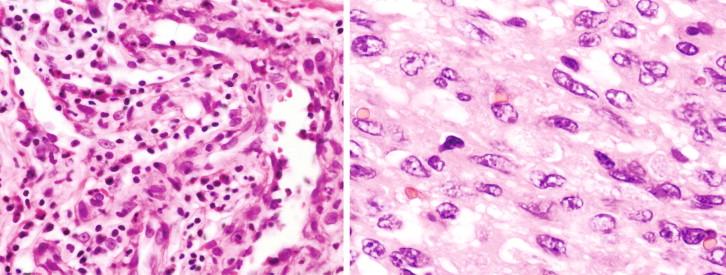
Become a Clinical Tree membership for Full access and enjoy Unlimited articles
If you are a member. Log in here